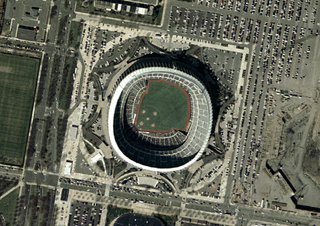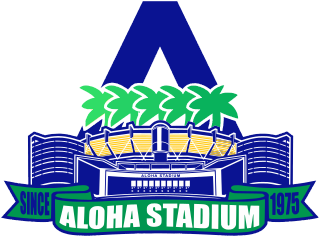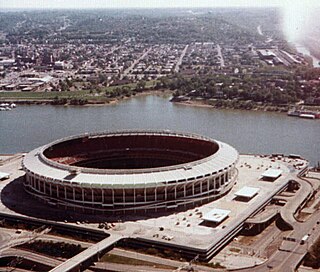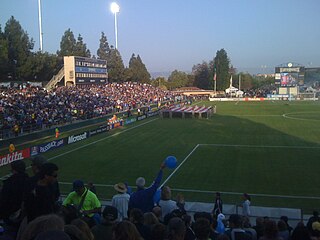
A stadium is a place or venue for (mostly) outdoor sports, concerts, or other events and consists of a field or stage either partly or completely surrounded by a tiered structure designed to allow spectators to stand or sit and view the event.

The Hubert H. Humphrey Metrodome was a domed sports stadium located in downtown Minneapolis, Minnesota. It opened in 1982 as a replacement for Metropolitan Stadium, the former home of the National Football League's (NFL) Minnesota Vikings and Major League Baseball's (MLB) Minnesota Twins, and Memorial Stadium, the former home of the Minnesota Golden Gophers football team.

Metropolitan Stadium was an outdoor sports stadium in the north central United States, located in Bloomington, Minnesota, a suburb of Minneapolis.

Veterans Stadium was a multi-purpose stadium in Philadelphia, Pennsylvania, United States, at the northeast corner of Broad Street and Pattison Avenue, part of the South Philadelphia Sports Complex. The seating capacities were 65,358 for football, and 56,371 for baseball.

Aloha Stadium is a closed multi-purpose stadium located in Halawa, Hawaii, a census-designated place that is a western suburb of Honolulu. It is the largest stadium in the state of Hawaii. As of December 2020, the stadium ceased fan-attended operations indefinitely, and placed a moratorium on the scheduling of new events. It is located next to the Hālawa station of the Skyline rail system.

Hard Rock Stadium is a multi-purpose stadium located in Miami Gardens, Florida, United States. The stadium is the home field for the Miami Dolphins of the National Football League (NFL) and the Miami Hurricanes, the University of Miami's NCAA Division I college football team.

Memorial Stadium, also known as the "Brick House", was an outdoor athletic stadium in the north central United States, located on the campus of the University of Minnesota in Minneapolis. It was the home of the Minnesota Golden Gophers football team for 58 seasons, from 1924 through 1981. Prior to 1924, the Gophers played at Northrop Field.

Riverfront Stadium, also known as Cinergy Field from 1996 to 2002, was a multi-purpose stadium in Cincinnati, Ohio. It was the home of the Cincinnati Reds of Major League Baseball (MLB) from 1970 through 2002 and the Cincinnati Bengals of the National Football League (NFL) from 1970 to 1999. Located on the Ohio River in downtown Cincinnati, the stadium was best known as the home of "The Big Red Machine", as the Reds were often called in the 1970s.

San Diego Stadium was a multi-purpose stadium in San Diego, California. The stadium opened in 1967 as San Diego Stadium and was known as Jack Murphy Stadium from 1981 to 1997. From 1997 to 2017, the stadium's naming rights were owned by San Diego-based telecommunications equipment company Qualcomm, and the stadium was known as Qualcomm Stadium or simply The Q. The naming rights expired on June 14, 2017, and were purchased by San Diego County Credit Union, renaming the facility as SDCCU Stadium on September 19, 2017; those naming rights expired in December 2020. Demolition of San Diego Stadium began in December 2020 with the last freestanding section of the stadium's superstructure felled by March 22, 2021. Following the demolition of San Diego Stadium, the San Diego State Aztecs' new Snapdragon Stadium, which opened in August 2022, was built in a different area of the parking lot.

The Los Angeles Memorial Coliseum is a multi-purpose stadium in the Exposition Park neighborhood of Los Angeles, California, United States. Conceived as a hallmark of civic pride, the Coliseum was commissioned in 1921 as a memorial to Los Angeles veterans of World War I. Completed in 1923, it will become the first stadium to have hosted the Summer Olympics three times when it hosts the 2028 Summer Olympics; the stadium previously hosted the Summer Olympics in 1932 and 1984. It was designated a National Historic Landmark on July 27, 1984, a day before the opening ceremony of the 1984 Summer Olympics.

Mile High Stadium was an outdoor multi-purpose stadium located in Denver, Colorado, from 1948 to 2001.

The Alamodome is a 64,000-seat domed indoor multi-purpose stadium in San Antonio, Texas. It is located on the southeastern fringe of downtown San Antonio. The facility opened on May 15, 1993, having been constructed at a cost of $186 million.

Soccer-specific stadium is a term used mainly in the United States and Canada to refer to a sports stadium either purpose-built or fundamentally redesigned for soccer and whose primary function is to host soccer matches, as opposed to a multi-purpose stadium which is for a variety of sports. A soccer-specific stadium may host other sporting events and concerts, but the design and purpose of a soccer-specific stadium is primarily for soccer. Some facilities have a permanent stage at one end of the stadium used for staging concerts.

Huntington Bank Stadium is an outdoor stadium located on the campus of the University of Minnesota in Minneapolis, Minnesota, United States. The stadium opened in 2009, after three years of construction. It is the home field of the Minnesota Golden Gophers of the Big Ten Conference.

A ballpark, or baseball park, is a type of sports venue where baseball is played. The playing field is divided into two field sections called the infield and the outfield. The infield is an area whose dimensions are rigidly defined in part based on the placement of bases, and the outfield is where dimensions can vary widely from ballpark to ballpark. A larger ballpark may also be called a baseball stadium because it shares characteristics of other stadiums.

An all-seater stadium is a sports stadium in which every spectator has a seat. This is commonplace in professional association football stadiums in nations such as the United Kingdom, Spain, and the Netherlands. Most association football and American football stadiums in the United States and Canadian Football League stadiums in Canada are all-seaters, as are most baseball and track and field stadiums in those countries. A stadium that is not an all-seater has areas for attendees holding standing-room only tickets to stand and view the proceedings. Such standing areas are known as terraces in Britain. Stands with only terraces used to dominate the football attendance in the UK. For instance, the South Bank Stand behind the southern goal at Molineux Stadium, home of Wolverhampton Wanderers, had a maximum of 32,000 standing attenders, while the rest of the stadium hosted a little bit less than that; the total maximum attendance was around 59,000.

Stevens Stadium is a 7,000-seat soccer stadium on the west coast of the United States, located on the campus of Santa Clara University in Santa Clara, California. The stadium is the current home of the Santa Clara Broncos soccer teams and was the former home of the now-defunct football team as well as the baseball team. The baseball team moved to their new home at Stephen Schott Stadium in 2005.
Throughout the years, a number of teams in the National Football League (NFL) have either moved or merged.

A multi-purpose stadium is a type of stadium designed to be easily used for multiple types of events. While any stadium could potentially host more than one type of sport or event, this concept usually refers to a specific design philosophy that stresses multifunctionality over specificity. It is used most commonly in Canada and the United States, where the two most popular outdoor team sports—Canadian football or American football and baseball—require radically different facilities. Football uses a rectangular field, while baseball is played on a diamond with a large outfield. Since Canadian football fields are larger than American ones, the design specifications for Canadian facilities are somewhat less demanding. The particular design to accommodate both is usually an oval, although some later designs use an octorad. While building stadiums in this way means that sports teams and governments can share costs, it also presents some challenges.

U.S. Bank Stadium is an enclosed stadium located in downtown Minneapolis, Minnesota. Built on the former site of the Hubert H. Humphrey Metrodome, the indoor stadium opened in 2016 and is the home of the Minnesota Vikings of the National Football League (NFL); it also hosts early season college baseball games of the University of Minnesota Golden Gophers.



















